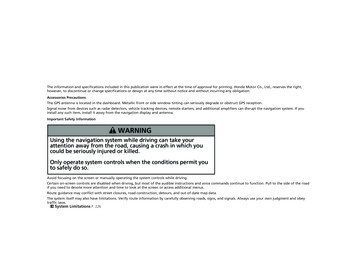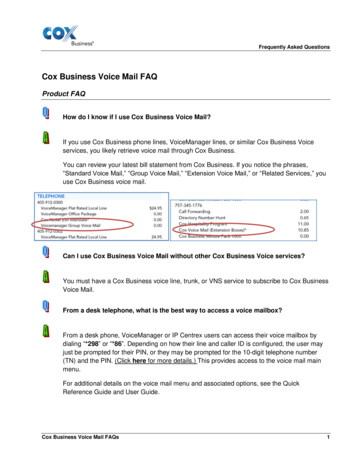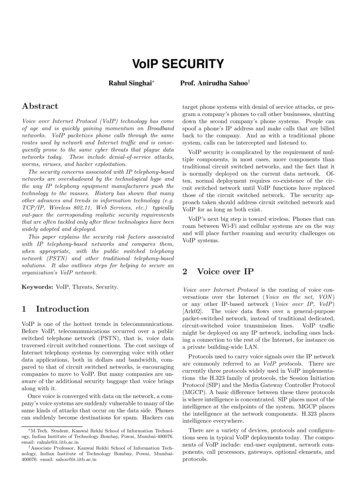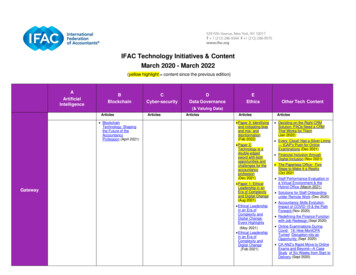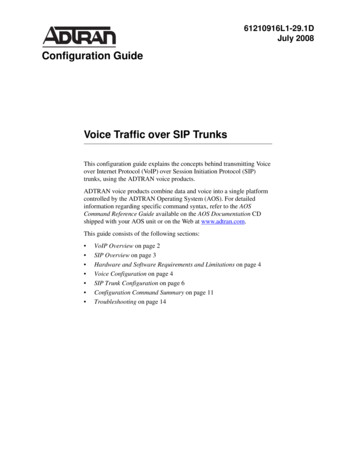
Transcription
ARTICLESQUIETING THE SHAREHOLDERS’VOICE: EMPIRICAL EVIDENCE OFPERVASIVE BUNDLING IN PROXYSOLICITATIONSJAMES D. COX, FABRIZIO FERRI, COLLEEN HONIGSBERG, AND RANDALL S.THOMAS*ABSTRACTThe integrity of shareholder voting is critical to the legitimacy ofcorporate law. One threat to this process is proxy “bundling,” or thejoinder of more than one separate item into a single proxy proposal.Bundling deprives shareholders of the right to convey their views on eachseparate matter being put to a vote and forces them to either reject theentire proposal or approve items they might not otherwise wantimplemented.In this Paper, we provide the first comprehensive evaluation of the* James D. Cox is the Brainerd Currie Professor of Law, Duke University School of Law;Fabrizio Ferri is the Regina Pitaro Associate Professor of Business at the Columbia Business School,Columbia University; Colleen Honigsberg is an Assistant Professor of Law at Stanford Law School;Randall S. Thomas is the John S. Beasley II Professor of Law and Business at Vanderbilt Law School,and a Professor of Management at the Owen Graduate School of Management at Vanderbilt University.The authors are deeply grateful for the research assistance of Messrs. Daniel Rowe and TheodoreEdwards in preparing this Article. A previous version of this paper was circulated under the title AreCompanies Impermissibly Bundling Proposals for Shareholder Votes?1179
1180SOUTHERN CALIFORNIA LAW REVIEW[Vol. 89:1179anti-bundling rules adopted by the Securities and Exchange Commission(“SEC”) in 1992. While we find that the courts have carefully developed aframework for the proper scope and application of the rules, the SEC andproxy advisory firms have been less vigilant in defending this instrumentalshareholder right. In particular, we note that the most recent SECinterpretive guidance has undercut the effectiveness of the existing rules,and that, surprisingly, proxy advisory firms do not have well-definedheuristics to discourage bundling.Building on the theoretical framework, this Article provides the firstlarge-scale empirical study of bundling of management proposals. Wedevelop four possible definitions of impermissible bundling and, utilizing adata set of over 1,300 management proposals, show that the frequency ofbundling in our sample ranges from 6.2 percent to 28.8 percent (dependingon which of the four bundling definitions is used). It is apparent thatbundling occurs far more frequently than indicated by prior studies.We further examine our data to report the items that are mostfrequently bundled and to analyze the proxy advisors’ recommendationsand the voting patterns associated with bundled proposals. This Articleconcludes with important implications for the SEC, proxy advisors, andinstitutional investors as to how each party can more effectively deterimpermissible bundling and thus better protect the shareholder franchise.TABLE OF CONTENTSINTRODUCTION . 1181I. SHAREHOLDERS’ VOICE vs. MANAGEMENT’S STRATEGICADVANTAGES IN TODAY’S CORPORATE FRAMEWORK . 1184A. NEXUS OF CONTRACTS IDEOLOGY . 1185B. RELATIVE BARGAINING POWER OF SHAREHOLDERS ANDMANAGERS . 11871. Charter Amendments . 11872. Bylaw Amendments. 1188II. THE UNBUNDLING RULES. 1191A. BUNDLING IN THE COURTS . 11931. Koppel v. 4987 Corp. . 11932. Greenlight Capital, L.P. v. Apple, Inc. . 1195B. SEC RESPONSES TO KOPPEL AND GREENLIGHT CAPITAL . 11981. The SEC’s 2004 Guidance & the 2015 Compliance andDisclosure Interpretation . 11982. The SEC’s 2014 Compliance and Disclosure Interpretation . 1200C. PROXY ADVISORS AND BUNDLING . 1205
2016]QUIETING THE SHAREHOLDERS’ VOICE1181III. DISTINGUISHING AMONG BUNDLES OF BUNDLING. 1208A. GENERIC BUNDLING . 1208B. MATERIAL BUNDLING . 1210C. MULTIPLE MATERIAL BUNDLING . 1214D. NEGATIVE BUNDLING . 1217IV. EMPIRICAL ANALYSIS: FREQUENCY OF BUNDLING . 1221A. SAMPLE SELECTION . 1221B. HOW MUCH BUNDLING OCCURS? . 12241. Generic Bundling . 12252. Material Bundling . 12253. Multiple Material Bundling . 1226C. WHAT TYPES OF PROPOSALS DO COMPANIES BUNDLETOGETHER?. 1226V. EMPIRICAL ANALYSIS: SHAREHOLDER VOTING ONBUNDLED PROPOSALS . 1233CONCLUSIONS AND POLICY RECOMMENDATIONS . 1240INTRODUCTIONThe shareholders’ franchise to vote provides the ideologicalunderpinning that “legitimates the exercise of power by some (directorsand officers) over vast aggregations of property that they do not own.”1While historically both state and federal law protected the legitimacy ofcorporate voting, beginning in 1934 with the passage of Section 14 of the1934 Exchange Act, federal law has taken the laboring oar in safeguardingshareholders’ voting rights. 2 In particular, Section 14 constructs anelaborate regulatory framework around the format, content, and timing ofproxy statements and proxy cards that public companies send to theirinvestors in preparation for their shareholder meetings to elect directors andto vote on other corporate matters requiring shareholder approval. Theanimating philosophy behind Congress’s enactment of Section 14 and the1. Blasius Indus., Inc. v. Atlas Corp., 564 A.2d 651, 659 (Del. Ch. 1988). Shareholders havefew rights and the few they enjoy are deeply qualified. See, e.g., Lucian A. Bebchuk, The Myth of theShareholder Franchise, 93 VA. L. REV. 675, 676 (2007); Julian Velasco, The Fundamental Rights ofShareholders, 40 U.C. DAVIS L. REV. 407, 407 (2006). Nonetheless, the right to vote, whether in theelection of directors or matters that corporate law requires at least the consent of the shareholders, isfoundational to the governance model of the modern public corporation. For an insightful review ofdifferent views of the purpose behind the power to vote, see Robert B. Thompson & Paul H. Edelman,Corporate Voting, 62 VAND. L. REV. 129, 145–52 (2009) (embracing the important role of shareholdervoting based on “error correction” in the firm’s stock price while rejecting other theories, including thatvoting addresses the “incomplete contract” problems in business settings).2. See, e.g., 2 JAMES D. COX & THOMAS L. HAZEN, COX & HAZEN ON CORPORATIONS § 13.30(3d ed. 2010).
1182SOUTHERN CALIFORNIA LAW REVIEW[Vol. 89:1179SEC’s proxy rules is that shareholders need to be fully informed about allof the matters on which corporate law requires their approval. Indeed, theproxy rules are central to governance of public companies.In 1992, the SEC greatly strengthened the shareholder franchisethrough a suite of amendments to the proxy rules. 3 Among the changesintroduced by the 1992 amendments were two rules, referred to as the“Unbundling Rules,” 4 that prohibit companies from “bundling” togethermultiple voting items into a single proposal with a single box on the proxycard. The SEC’s rules target such bundled proposals since they distortshareholder choice, and thereby disenfranchise shareholders. Bundling hasanother harmful effect: joining in one resolution two distinct substantiveitems has the necessary effect of preventing shareholders from expressingtheir views to directors on each matter being put to a vote. In other words,the joinder of unrelated substantive items causes shareholders to approveitems that they might not otherwise want implemented and also robs thedirectors of awareness of the shareholders’ views on each bundledproposal. While these basic principles are easily stated, in practice the ruleshave been difficult to implement and, as developed below, have beenfurther muddled by SEC interpretations that lack the support of both theSEC’s initial regulatory guidance on bundling and the relevant case law.In this Paper we provide the first comprehensive evaluation of theSEC’s Unbundling Rules. We begin in Part I with a discussion of thecorporate governance framework where we see that management enjoysnumerous practical and legal strategic advantages. These advantages are instark contrast with the prevalent “nexus of contracts” perspective ofcorporate law where consent by owners is a central cog in the governancewheel. The perspective gained in this discussion underscores theimportance of the shareholder vote, a matter that is directly implicated bythe practice of bundling.In Part II of the Paper, we provide a careful dissection of the rulesthemselves as well as a close analysis of their interpretation by the courts3. In addition to addressing bundling, the SEC also acted to address how regulation contributesto the collective action problem among investors in public companies. See Regulation ofCommunications Among Shareholders, Exchange Act Release No. 31,326, 57 Fed. Reg. 48,276 (Oct.22, 1992) (to be codified at 17 C.F.R. pts. 240, 249) [hereinafter Communications Release] (adopting awide number of amendments to the proxy rules with the cumulative effect of enabling greater freedomto interact among shareholders and their advisors in connection with proxy voting). These sweepingchanges were first proposed in Regulation of Communications Among Securityholders, Exchange ActRelease No. 30,849, 57 Fed. Reg. 29,564 (proposed July 2, 1992) (to be codified at 17 C.F.R. pts. 240,249) [hereinafter Communications Among Securityholders].4. Exchange Act Rules, 17 C.F.R. §§ 240.14a-4(a)(3), (b)(1) (2014).
2016]QUIETING THE SHAREHOLDERS’ VOICE1183and the SEC. We find that the courts have carefully developed severalinterpretative approaches to define impermissible bundling. In contrast, weshow that the SEC’s approach to its own rules has become less vigorousand, as we ultimately conclude, inconsistent with the goals it announced forthe rules when they were adopted. Indeed, we conclude that the SECinterpretive guidance has undercut the effectiveness of the existing rulesand created unnecessary ambiguity about their proper application.We conclude Part II with an examination of the voting policies ofthird party voting advisors that counsel investors how to vote on proxyproposals. We find that, surprisingly, these advisors have not developedany analytical structures for dealing with bundled proposals. We examinethe voting policies of the two major voting advisors, InstitutionalShareholder Services (“ISS”) and Glass Lewis. We find each has failed toprovide clear advice to their clients to vote against bundled proposals.Instead of operating from well-developed heuristics for detecting harmfulbundling, the advisors act on an ad hoc basis, applying balancing tests todetermine whether the bundled proposals predominantly benefit or harmshareholders, with the end result being muddled outcomes.In Part III, to illustrate the spectrum of possible definitions ofimpermissible bundling, we offer four possible classifications of bundling.The four types range from the broadest to the most narrow: (1) anyproposal with more than one item5 (we refer to this as “generic bundling”);(2) any proposal with more than one item, where at least one of those itemsis material (“material bundling”); (3) any proposal with more than oneitem, where two or more of those items are material (“multiple materialbundling”); and (4) any proposal with more than one item, where at leastone of those items is material and negatively affects shareholders rights(“negative bundling”). We also provide various examples of egregiousbundling to highlight the importance of this problem.Part IV of the Paper applies our four potential tests to a large sampleof actual shareholder votes to determine the prevalence of bundling underour alternative definitions. Under each of these definitions, we find thatcompanies engage in impermissible bundling far more frequently thanindicated by prior research. Using a ten-year data set containing a total of1,349 management proposals, we find some form of bundling was presentin 28.8 percent of those proposals, while nearly 80 percent of the bundling5. Across the four definitions, by “more than one item” we mean “more than one substantivelydifferent item.” That is, we would not consider a substantively single item with multiple components tobe a case of bundling.
1184SOUTHERN CALIFORNIA LAW REVIEW[Vol. 89:1179uncovered involved multiple items with a material impact on theshareholders.Next, in Part V, we examine shareholder voting on bundled proposals.In particular, we provide empirical evidence for how proxy advisorsrespond to bundling, their recommendations in connection with bundledproposals, and how shareholders vote on bundled proposals. These dataprovide more insight on the response of proxy advisors to bundling and theimpact of proxy advisors’ recommendations.We conclude in Part VI with a discussion of the policy implications ofour findings. We provide specific recommendations for both the SEC andthe third party voting advisors so that the pervasive bundling practice wereport here can be addressed and the shareholder franchise can be liberatedfrom the chains of bundling.I. SHAREHOLDERS’ VOICE vs. MANAGEMENT’S STRATEGICADVANTAGES IN TODAY’S CORPORATE FRAMEWORKAbuses of shareholders’ voting rights led to the adoption of Section 14of the 1934 Exchange Act. 6 Congress’s action “stemmed from thecongressional belief that ‘[f]air corporate suffrage is an importantright . . . .’ It was intended to ‘control the conditions under which proxiesmay be solicited with a view to preventing the recurrence of abuseswhich . . . [had] frustrated the free exercise of the voting rights ofstockholders.’”7 Over the ensuing decades, the SEC has been vigilant inprotecting shareholder voting rights against potential managerial abuses.In addition to the election of directors, for which SEC rules strictlyproscribe bundling, 8 shareholder voting customarily arises in threeimportant areas: charter and bylaw amendments, transactions involvingacquisitions, and executive compensation. 9 Without diminishing the6. COX & HAZEN, supra note 2, at 545.7. J. I. Case Co. v. Borak, 377 U.S. 426, 431 (1964) (quoting H.R. REP. NO. 73-1383, at 13–14(1934)).8. In contrast to the approach in the Unbundling Rules—which generally prescribe separatevotes for each separate matter and naturally lead to questions as to what is a separate matter—the SECproxy rules take a more definitive approach. In the election of directors, to prevent multiple nominees tothe board being subject only to a single vote, the SEC proxy rules provide that the proxy form mustinclude a means by which voting shareholders can withhold their vote from any director. 17 C.F.R.§ 240.14a-4(b)(1). The rules then set forth three distinct nonexclusive means for shareholders towithhold their vote. § 240.14a-4(b)(2).9. See Paul H. Edelman et al., Shareholder Voting in an Age of Intermediary Capitalism, 87 S.CAL. L. REV. 1359, 1367–68 (2014). While there are a variety of other situations that involveshareholder voting, they are not important for our purposes because they are unlikely to implicate the
2016]QUIETING THE SHAREHOLDERS’ VOICE1185importance of the shareholder voice in approving an acquisition 10 orexecutive compensation,11 our study focuses on amendments to either thecharter or the bylaws because, in the contemporary legal context, thecharter and the bylaws are what define the shareholders’ relationship to thefirm. As the next section develops, meaningful shareholder consent iscentral to the modern perspective of the public company. To this end, theUnbundling Rules were adopted by the SEC to protect the exercise of thatconsent.A. NEXUS OF CONTRACTS IDEOLOGYThe most important perspective that shapes corporate law today is theview that the corporation is a “nexus of contracts.” Building on RonaldCoase’s perspective on why firms exist (labor, suppliers, customers,investors, and managers arrange their activities to their optimal benefit),12leading legal scholars, and in turn practitioners, embrace private orderingas the desired norm within corporate law. In a world of private ordering,the state corporate statute is understood to have the limited role ofproviding default rules in those instances where the parties have nototherwise specified how their affairs or activities are to occur.13Frank Easterbrook and Daniel Fischel were early advocates forviewing corporate law as consensual. Much of their embrace of the nexusof contracts theory was based on their belief that it is necessary for businessissues discussed in this paper (for example, shareholder initiated votes using Rule 14a-8, mandatorysay-on-pay votes, or contested elections which involve single items with a single voting box on theballot).10. Shareholder voting is also important for some types of M&A activity. For instance, understate corporate law, mergers and consolidations require shareholder approval by both companiesinvolved in the transaction. See, e.g., DEL. CODE ANN. tit. 8, § 251(c) (2016); MODEL BUS. CORP. ACT§ 11.04(d) (AM. BAR ASS’N 2007). There are exceptions to these mandatory voting requirements for theshareholders of an acquiring company in a small-scale merger. See, e.g., DEL. CODE ANN.tit. 8, § 251(f); MODEL BUS. CORP. ACT § 11.04(g). More narrowly, sales of all or substantially all ofthe assets of a corporation require the approval of only the selling corporation’s shareholders. See, e.g.,DEL CODE ANN. tit. 8, § 271; MODEL BUS. CORP. ACT § 12.02. There are also exceptions forshareholders of a subsidiary corporation when the acquirer invokes the short-form merger process. See,e.g., DEL. CODE ANN. tit. 8, § 253 (requiring at least 90 percent ownership by parent); MODEL BUS.CORP. ACT § 11.05 (same).11. In the executive compensation area, shareholder voting is necessary for most stock optionplans. See Randall S. Thomas & Kenneth J. Martin, The Determinants of Shareholder Voting on StockOption Plans, 35 WAKE FOREST L. REV. 31, 47–48 (2000).12. See generally, R. H. Coase, The Nature of the Firm, 4 ECONOMICA 386 (1937).13. See, e.g., Frank H. Easterbrook & Daniel R. Fischel, The Corporate Contract, 89 COLUM. L.REV. 1416, 1426 (1989) (referring to the corporation as a “nexus of contracts,” which “is just short handfor the complex arrangements of many sorts that those who associate voluntarily in the corporation willwork out among themselves”).
1186SOUTHERN CALIFORNIA LAW REVIEW[Vol. 89:1179enterprises to be “adaptive” because organizations, and their actors, arebuffeted by an ever-changing business environment. 14 Businesses, theyargued, are dynamic entities best served by adaptive actors. From thisperspective, it is natural to conclude that the law should accommodate thisreality. To this end, they reason that owners and managers must be able totailor their relationship to ever-changing circumstances. To nexus ofcontracts adherents, corporate rules are not mandatory, but default rules;the parties are free to tailor the relationship to their own particular needs.15Pursuant to this view, corporate law as provided by the state is merelyfacilitative of private bargaining––corporate law is not public, but privatelaw. In such a realm, the only issue in doubt is what constitutes consentamong the affected parties; after all, the consent that Coase and contracttheory so heavily depend upon as the basis for the efficiency is the outcomeof bargaining.Because consent is a necessary feature for the contractual paradigmand therefore is foundational to corporate law today, the efficacy of proxyvoting is of great import; simply stated, because a contract arises when andonly when there is a meeting of the minds on the parties’ respectiveundertakings, choice, both free and informed, is central to the relationshipowners have to their corporation. 16 The best way to insure that theshareholders consent to entering into, or altering, the corporate contract isby seeking their fully informed approval of that contract or any changes toit. Informed shareholder voting is an obvious solution to the question ofhow to obtain such consent.1714. See id. at 1428.15. See id. at 1434–36.16. Consent and contracting can be found within the shareholder’s relationship to thecorporation; but that relationship is richer and potentially more fluid than contractual relationshipsbecause of a set of governance arrangements and procedures that permeate corporate statutes andthereby define corporate organizations. See, e.g., Lawrence A. Hamermesh, Consent in Corporate Law,70 BUS. LAW. 161, 162 (Winter 2014/15) (arguing that consent is also a necessary component ofgovernance). Consent can be found at the moment the shareholder purchases shares in the corporation;the transaction is bound by consideration on the part of the corporation and the shareholder, and theterms of their bargain are set forth in the laws of the state of incorporation, the articles of incorporation,and the bylaws. Thereafter, changes in this contract can be understood to occur when the state ofincorporation amends its corporate statute, the corporation amends its articles of incorporation, or thebylaws are amended.17. Recent decisions in Delaware, although invoking the nexus of contracts approach, haveinvited close scrutiny of what constitutes consent as well as the soundness of the nexus of contractsperspective. In Boilermakers Local 154 Retirement Fund v. Chevron Corp., Chancellor Strine held thatthe board acting without the consent of the shareholders could nonetheless adopt a bylaw provision thatpermitted the corporation to choose the forum in which a shareholder-initiated suit would bemaintained. Boilermakers Local 154 Ret. Fund v. Chevron Corp., 73 A.3d 934, 939 (Del. Ch. 2013).
2016]QUIETING THE SHAREHOLDERS’ VOICE1187B. RELATIVE BARGAINING POWER OF SHAREHOLDERS AND MANAGERSInside this contractual framework, management, not the shareholders,enjoys a significant strategic advantage within the dynamics of thecorporate web within which the shareholder contract exists. It is this pointthat raises our concern for bundling. Consider that the corporate documentsare the supreme source of the contract that exists between the corporationand its shareholders. Shareholders and managers, however, do not approachchanges in the charter or bylaws on the same footing.1. Charter AmendmentsAny change to the corporate charter must first be proposed by theboard of directors18 so that the shareholders’ role is reactive, not proactive,in shaping the change that is proposed. Because of this, management enjoysa strategic advantage over shareholders in controlling the timing, details,and information that surrounds the proposal.19 Further adding to the powerThis decision was followed by ATP Tour, Inc. v. Deutscher Tennis Bund where the Delaware SupremeCourt, relying on the reasoning in Boilermakers, upheld a board-adopted bylaw concerning litigationcosts that abandoned the long-maintained “American Rule” whereby litigants bear their own costs, andinstead made the plaintiff bear the defendant’s expenses—which would include the corporation’s costsin a derivative suit—unless the plaintiff prevailed. ATP Tour, Inc. v. Deutscher Tennis Bund, 91 A.3d554, 558 (Del. 2014). Boilermakers and ATP Tour each reasoned from the perspective that theshareholders’ relationship with the corporation, and in turn their relationship to the board of directors, iscontractual so that much of the shareholders’ rights can be understood to flow from certain organicdocuments, and most significantly and pervasively from the company’s bylaws.It is not our purpose here to question the force or legality of such unilateral action. Instead weinvoke the controversy that has surrounded Boilermakers and ATP Tour as a testament of theimportance society assigns to shareholder voting. As we noted earlier, in Atlas, former Chancellor Allenobserved that it is the shareholders’ voting franchise that provides the ideological underpinning that“legitimates the exercise of power by some (directors and officers) over vast aggregations of propertythat they do not own.” Blasius Indus., Inc. v. Atlas Corp., 564 A.2d 651, 659 (Del. Ch. 1988). Buildingon this insight, we believe the results reached in both decisions would have been significantly lesscontroversial, and likely not controversial at all, had the bylaws been adopted with the approval of theshareholders. Not only does such approval improve the optics of the transaction that otherwise can beseen as self-serving on the part of the directors (who are likely to be the targets of shareholder suits),but such approval would more easily fall within prevailing notions of governance while obtaining thetype of consent on which the nexus of contracts paradigm invokes the least controversy. However, thedata collected and analyzed in this study raises a good deal of disquiet regarding the vulnerability of theshareholder franchise. That is, our empirical analysis identifies many instances in which impermissiblebundling likely distorted the outcomes of proxy votes—suggesting that even proposals adopted withshareholder consent may be controversial because self-interested managers can skew the voting process.18. See, e.g., DEL. CODE ANN. tit. 8, § 242(b)(1) (2016); MODEL BUS. CORP. ACT § 10.03(a)(AM. BAR ASS’N 2007).19. Lucian A. Bebchuk, The Case for Increasing Shareholder Power, 118 HARV. L. REV. 833,863 (2005) (“Management . . . has the sole power to put proposals on the table, and shareholders haveto vote up or down on these proposals without having the option to amend them.”). The power to set theagenda also enables management to obtain approval of measures which decrease shareholder value. Id.
1188SOUTHERN CALIFORNIA LAW REVIEW[Vol. 89:1179imbalance is the well-known collective action problem that weakens theshareholders’ voice. 20 Such concerns regarding the imbalance of powerbetween managers and owners support the view that when interpreting theproxy rules, such as the Unbundling Rules, the potential of adverseconsequences on the critical role of consent should be fully understood, sothat at least when changes to the corporate charter are being proposed theimbalance is not exacerbated.2. Bylaw AmendmentsIn contrast to corporate law’s treatment of amending the charter,bylaws can be initiated by the shareholders as well as by the board ofdirectors.21 Nonetheless, a board acting to amend the bylaws enjoys threestrategic advantages over shareholders who seek to change theirrelationship to the corporation through amending the bylaws.The first two advantages are grounded in economic theory. To beginwith, the informational advantages of those in control permit them not onlyto time a change to their own advantage, but to understand better thanoutside shareholders the full effects of a bylaw change they propose. As aconsequence of their information advantages, managers are well positionedto act opportunistically to pursue self-interested ends of which only theycan be fully aware. Second, insiders acting to amend bylaws do not face theformidable collective action problem that outside shareholders incur inmoving a bylaw through the approval process. While both boards andshareholders enjoy the right to amend the bylaws, the board, being acohesive body, as a practical matter enjoys lower costs and less uncertaintyby choosing the bylaw course of action. Indeed, under corporate law, anycost related to board-initiated actions is borne by the corporation, whereasthe shareholders’ cost to act, and most importantly to persuade fellowshareholders, is borne by the activist shareholder.Thirdly, the law tilts heavily against the shareholders in Americanpublic companies having the right to alter the fundamental structure of thecorporation; corporate statutes set forth the basic structure of thecorporation subject to countervailing provisions in the articles ofincorporation. Thus, if there are changes from the default rule thatcorporate affairs are managed by or under the direction of the board ofat 865.20. John C. Coates, IV, Measuring the Domain of Mediating Hierarchy: How Contestable AreU.S. Public Corporations?, 24 J. CORP. L. 837, 849 (1999) (closely examining weaknesses inshareholder voting due to the collective action problem).21. DEL. CODE ANN. tit. 8, § 109; MODEL BUS. CORP. ACT § 10.20.
2016]QUIETING THE SHAREHOLDERS’ VOICE1189directors, the preferred structure must appear in the articles ofincorporation. As discussed earlier, only the board of directors has thepower to initiate amendments to the articles of incorporation.22 This featureof American corporate law not only reduces the shareholders to a reactiverole in defining their governance structure, but also necessarily restricts thearea that is a proper subject for shareholder action.The Delaware Supreme Court’s holding in CA, Inc. v. AFSCMEEmploye
1180 SOUTHERN CALIFORNIA LAW REVIEW [Vol. 89:1179 anti-bundling rules adopted by the Securities and Exchange Commission ("SEC") in 1992. While we find that the courts have carefully developed a framework for the proper scope and application of the rules, the SEC and


